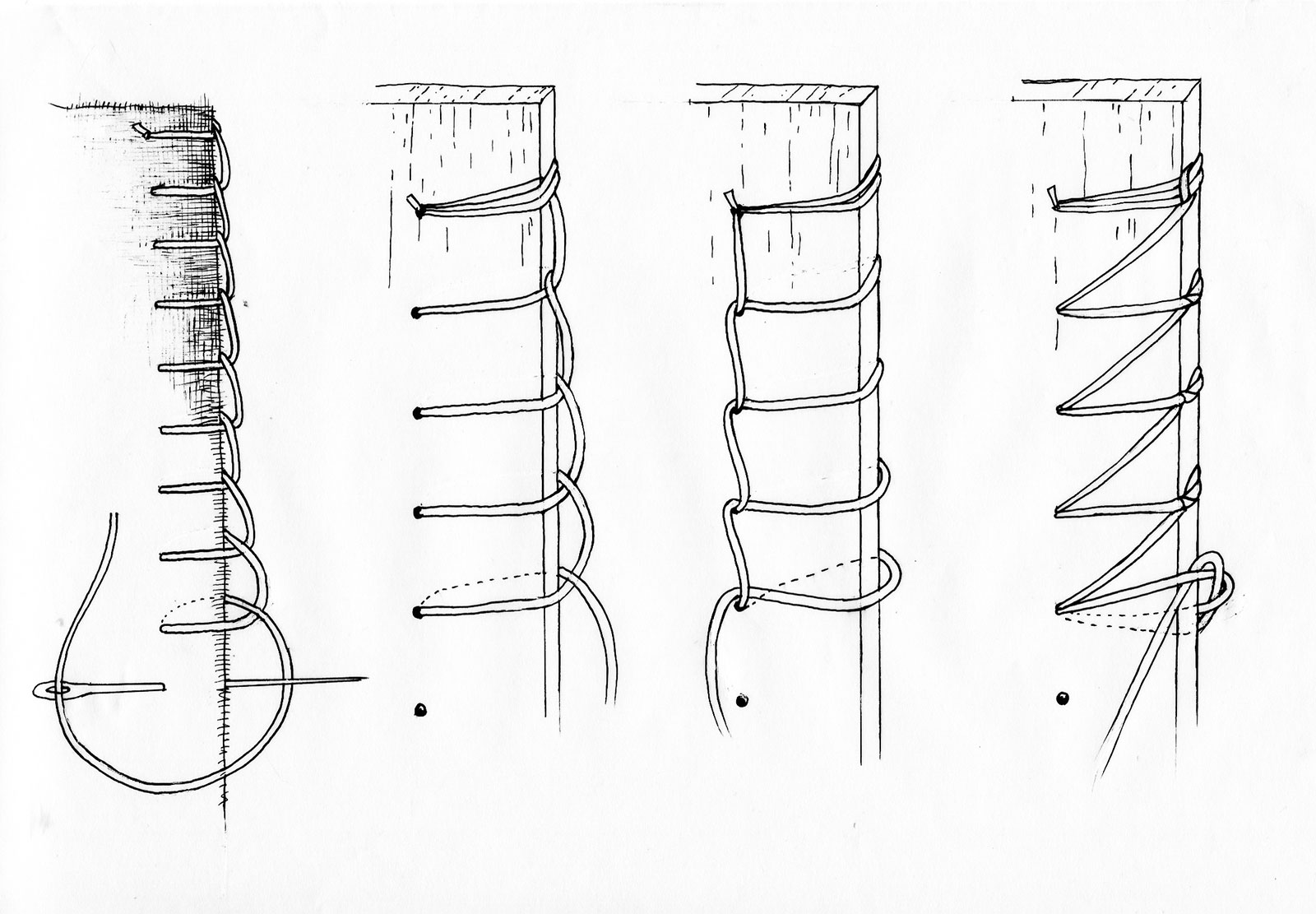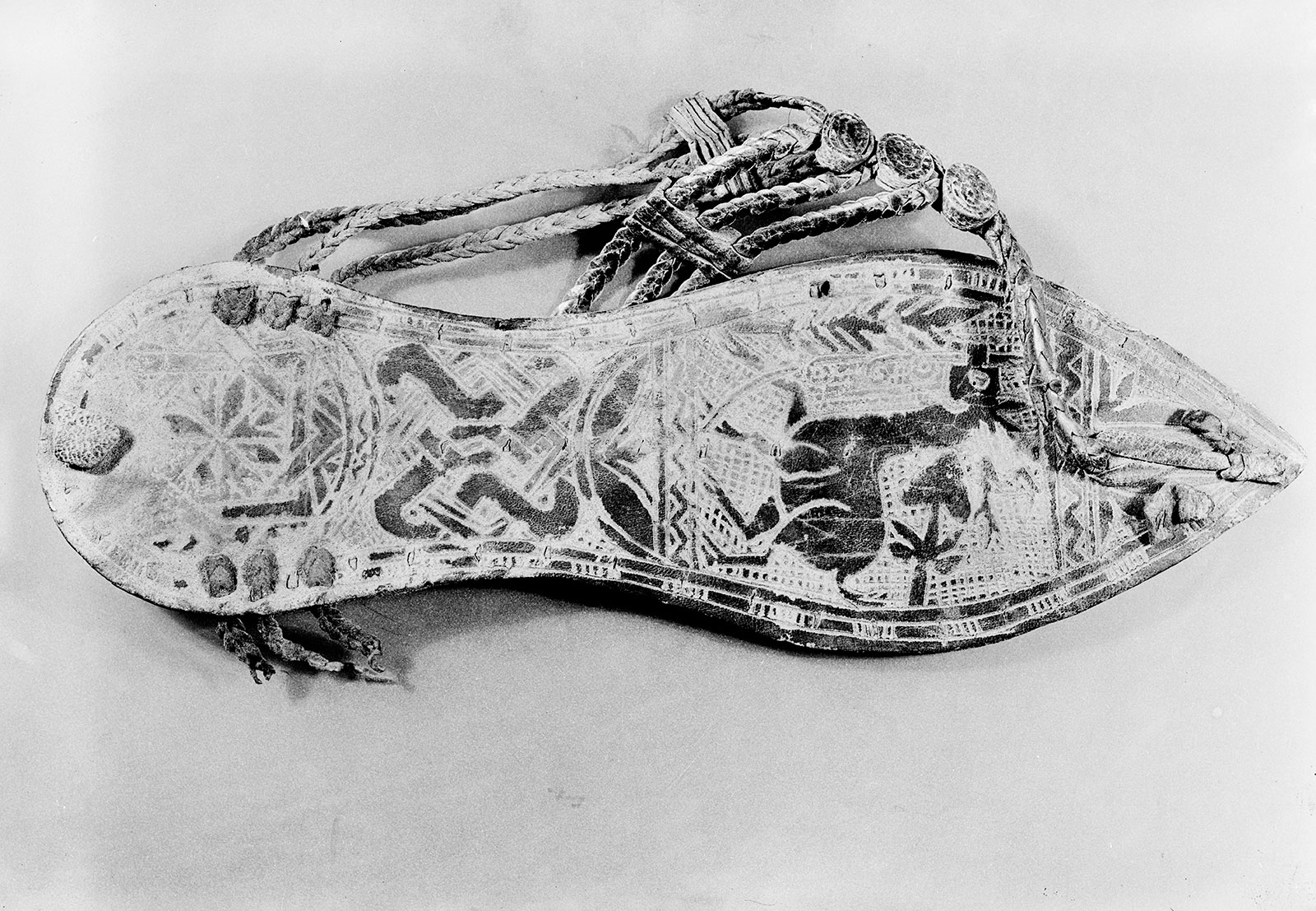The Codex and Crafts in Late Antiquity
CreditsSelect a codex component to explore further
Sewing the gatherings
A multigathering codex consists of folded sheets of papyrus, parchment, or paper, gathered together and sewn in a specific sequence. The sewing method is an adaptation of a fabric-making technique known by various names, including cross-knit looping (the term used in this exhibition), nålebinding, mesh stitch, ösenstitch, single needle knitting, encircled looping, knit-stem stitch, Coptic knitting, and looped needle netting. It is a simple but effective technique that combines strength and flexibility.
Sewing the gatherings
The gatherings are sewn together with a thread that passes through the centerfold and loops around the sewing of the previous gathering.

Sinai codex Greek 1155, with spine exposed, revealing the underlying unsupported sewing structure of the book block, 16th century AD. St. Catherine’s Monastery, Sinai, Egypt.
The technique for sewing the gatherings has remained nearly unchanged among most of the various bookbinding traditions that evolved in the Eastern Mediterranean from late antiquity through the twentieth century.
Cross-knit looping
The looping technique used to sew the gatherings of a codex is adapted from cross-knit looping, used to make socks and other garments, several of which have been found in late antique burials in Egypt, preserved by the dry climate.

Three variations of looping techniques commonly used for fabrics. Top: simple looping; middle: cross-knit looping; bottom: pierced looping.

Textile fragment made with cross-knit looping, Dura-Europos, ca. AD 200–256. Wool. Yale University Art Gallery, Yale-French Excavations at Dura-Europos, 1935.556.
This textile fragment, found in Syria, is evidence that cross-knit looping was used for garments in regions beyond Egypt.
Sewing endbands
Endbands are the sewn bands at the head (top) and tail (bottom) edges of the spine of a book, functioning much like edge finishes on textiles. Up until the late seventeenth and eighteenth centuries, endbands in Eastern Mediterranean bindings were always sewn through the gatherings of the book block, usually around a cord core. Their purpose was to compress and “seal” the edges of the book block and the spaces between the gatherings, to reinforce the attachment of the boards, and finally to decorate the book. Often endbands and textile edge finishes are made with the same techniques.
Wound endband
Unlike the loop-stitch endband, in this endband the thread is wound around a cord core in a continuous figure-eight movement. The cord core strengthens the connection of the boards to the book block.

The wound endband in Sinai codex Greek 213, AD 967, in contemporaneous binding. St. Catherine’s Monastery, Sinai, Egypt.
This is one of the earliest preserved examples of a wound endband. The technique is comparable to a common, simple method known as packed overcasting, used for reinforcing and decorating the edges of many woven items, from mats and baskets to textiles.
Loop-stich endbands
The loop-stitch endband is one of the most widespread types found on early codices. The same looping technique is used for sewing the codex book block and for reinforcing and decorating the edges of fabrics. The sewing starts from one board, continues through the book block, ending at the opposite board.

A diagram of the loop stitch in neck and armhole openings of an Egyptian tunic, ca. 9th–11th century AD. Egyptian Museum of Berlin, inv. no. 9917. Redrawn and adapted from Cäcilia Fluck, Petra Linscheid, and Susanne Merz, Textilien aus Ägypten (Wiesbaden: Reichert, 2000), 1:200.

Detail of an endband, 10th century AD. Originally on MS M.597, Homilies on the Incarnation and Virgin Mary, Fayum, Egypt. Leather, 2 1/8 × 1/4 in. (5.5 × 0.6 cm). The Morgan Library and Museum, Purchased for J. Pierpont Morgan, 1911, MS M.597A2F.
Although this fragment is very small, the endband appears to be sewn with the loop stitch.
Decorating the cover
The cover of a codex envelops the book’s spine and boards. A cover has to be flexible, strong, and suitable for different types of decoration. The material that best combines all these characteristics is tanned leather. Most bindings were decorated with a combination of techniques—tooling, inking and painting, cutout openwork and stitching, incising and scraping of the surface, gilding, and lacing—that were used extensively in shoemaking and other leatherwork well before the appearance of the multigathering codex.

Decorative tooling (detail), Sinai codex Georgian 32, AD 864. St. Catherine’s Monastery, Egypt.
The decoration of this codex cover is produced by pressing or hammering the leather with metal stamps, each of which bears a simple motif. The stamps are called “tools” in bookbinding terminology and the stamping process, “tooling.”

Upper cover and detail of Morgan MS. M.569, 9th–10th century AD. The Morgan Library and Museum, purchased for J. Pierpont Morgan, 1911. MS M.569A.
The decoration on the cover of this codex is produced using a variety of techniques: gilding, stitching, cutout openwork, and parchment strips laced though closely spaced slits cut through the red leather.

Artisans used the same techniques to decorate book covers (fragments, nos. 693 and 694), coiffure supports (nos. 702 and 703), and shoes (nos. 708, 709, and 712). From Abu Tig, Cairo, Giza, and Akhmin-Panapolis. From Oscar Konstantin Wulff, Altchristliche und mittelalterliche byzantinische und italienische Bildwerke, vol. 1 (Berlin: Reimer, 1909), fig. 30.
Attaching the boards
A multigathering codex usually has a pair of boards, front and back, to protect the book block (the sewn gatherings, ready for binding) and keep it compact. The boards are commonly made from wood or from layers of papyrus to provide stiffness and strength.
Attaching a board to an already sewn book block
The board is sewn to the book block using a simple sewing technique, similar to the blanket stitch, with the thread passing through the board and looping around the sewing of the gatherings.

The blanket stitch, widely used to reinforce and protect the edges of fabrics, is one method used for sewing the boards to the book block. The blanket stitch in a fabric (a) is shown alongside variations of thread hinging boards of Eastern Mediterranean book structures (b–d).
 a
a
 b
b
 c
c
Inner face of boards. Bindings of Morgan Library and Museum Coptic codices: (a) M.588, AD 9th century (b) M.597, AD 10th century, and (c) M.634, AD 9th-10th century. From Theodore C. Petersen, “Coptic Bookbindings in the Pierpont Morgan Library,” typescript, 1948
The book block and boards can be sewn together as one single sequence, or the book block can be sewn first, with the boards then sewn onto it separately, as shown in the animation. Inner face of the boards, showing the characteristic patterns created by the thread lacing the boards to the book blocks

Papyrus double document, written December AD 127. Courtesy Israel Antiquites Authority.
Techniques similar to those used for attaching the boards on early codices were used to secure and seal papyrus documents.
Making fastening straps
Fastening straps are an essential element of the early codex. They are used to protect the book by keeping it closed when it is not in use. Interlaced straps, the most common type found in late antiquity, are made with an ancient technique widely used for sandals and belts. The straps can be found on Byzantine and post-Byzantine bindings well into the seventeenth century.
Interlaced fastening straps
Although often referred to as braided, these fastening straps are in fact made by interlacing one leather strap through the other.

Fragment of a fastening strap originally on MS M.597, Egypt, 10th century AD. The Morgan Library and Museum, Purchased by J. Pierpont Morgan, 1911, MS M.597.

The sandal’s straps are made with the interlace technique, 401-600 AD. Egyptian. (war loss). Leather. Vorderasiatisches Museum, Staatliche Museen, Berlin, Germany, 4835.






